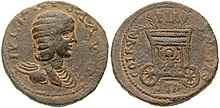
FROM WIKIPEDIA: Astarte was connected with fertility, sexuality, and war. Her symbols were the lion, the horse, the sphinx, the dove, and a star within a circle indicating the planet Venus. Pictorial representations often show her naked. She has been known as the deified morning and/or evening star.[2]
The deity takes on many names and forms among different cultures, and
according to Canaanite mythology, is one and the same as the
Assyro-Babylonian goddess Ištar, taken from the third millennium BC Sumerian goddess Inanna,
the first and primordial goddess of the planet Venus. Inanna was also
known by the Aramaic people as the god Attar, whose myth was construed
in a different manner by the people of Greece to align with their own
cultural myths and legends, when the Canaanite merchants took the First
papyrus from Byblos (the Phoenician city of Gebal) to Greece sometime
before the 8th century by a Phoenician called Cadmus the first King of
Thebes.[citation needed]
Astarte riding in a
chariot with four branches protruding from roof, on the reverse of a
Julia Maesa coin from
SidonAstarte was worshipped in Syria and Canaan beginning in the first millennium BC and was first mentioned in texts from Ugarit. She came from the same Semitic origins as the Mesopotamian goddess Ishtar, and an Ugaritic text specifically equates her with Ishtar. Her worship spread to Cyprus, where she may have been merged with an ancient Cypriot goddess. This merged Cypriot goddess may have been adopted into the Greek pantheon in Mycenaean and Dark Age times to form Aphrodite.
It has been argued, however, that Astarte's character was less erotic
and more warlike than Ishtar originally was, perhaps because she was
influenced by the Canaanite goddess Anat,
and that therefore Ishtar, not Astarte, was the direct forerunner of
the Cypriot goddess. Greeks in classical, Hellenistic, and Roman times
occasionally equated Aphrodite with Astarte and many other Near Eastern
goddesses, in keeping with their frequent practice of syncretizing other deities with their own.[3]
Allat the pre-Islamic Arabian deity and Astarte may have been assimilated to each other[5](p. 51), and the two were closely linked.[6]
On one of the tesserae used by the Bel Yedi'ebel for a religious
banquet at the temple of Bel the deity Allat was given the name Astarte
('štrt). The assimilation of Allat to Astarte is not surprising in a
milieu as much exposed to Aramaean and Phoenician influences as the one
in which the Palmyrene theologians lived.[7] Similar to Astarte, Allat was as well associated with morning star (Venus),[8][9][10][11][12] crescent,[13][14][15] war,[16][17] prosperity, and lions.[18][19]


